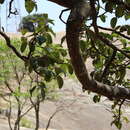Comments
provided by eFloras
This widespread and variable species has been divided into a number of varieties, two of which are recorded from the Flora area.
- license
- cc-by-nc-sa-3.0
- copyright
- Missouri Botanical Garden, 4344 Shaw Boulevard, St. Louis, MO, 63110 USA
Description
provided by eFloras
Trees, 10-15 m tall. Bark grayish white. Branches without aerial roots; branchlets 5-9 mm in diam., densely yellowish brown woolly. Stipules yellowish brown, lanceolate, 2-3 cm, membranous, with thick hairs. Petiole robust; 2.5-3 cm; leaf blade narrowly elliptic to obovate-elliptic, 15-18 × 5-9 cm, leathery, glabrous or abaxially yellowish brown woolly but glabrescent, adaxially green and glabrous or sparsely shortly pubescent or densely yellowish brown long pubescent but glabrescent, base rounded, ± cordate, or ± auriculate, margin entire or slightly undulate, apex acute; basal lateral veins 2-4, secondary veins 8-11 on each side of midvein, tertiary veins reticulate. Figs axillary on leafy branchlets, paired, reddish orange to red and with scattered white spots, oblong, pillow-shaped, or conic-ellipsoid, 1.5-2.5 × 1-1.5(-2) cm, glabrous or densely covered with brownish yellow long hairs, inside with few or no bristles, apical pore closed by 3 or 4 umbonate bracts, not forming flat disk, subsessile; involucral bracts orbicular to ovate-lanceolate, margin ciliate. Male, gall, and female flowers within same fig. Male flowers: long-pedicellate; calyx lobes 3, broadly ovate; stamen 1; filament short and thick; anther narrowly ellipsoid. Gall flowers: pedicellate; sepals connate, apically 3- or 4-lobed; ovary ± globose. Female flowers: calyx lobes 3, white, broadly lanceolate. Achenes ± globose, tuberculate. Fl. early summer.
- license
- cc-by-nc-sa-3.0
- copyright
- Missouri Botanical Garden, 4344 Shaw Boulevard, St. Louis, MO, 63110 USA
Distribution
provided by eFloras
Guangdong, Hainan, S Yunnan [Bangladesh, Bhutan, India, Indonesia, Laos, Malaysia, Myanmar, Nepal, New Guinea, Philippines, Sikkim, Sri Lanka, Thailand, Vietnam; NE Australia].
- license
- cc-by-nc-sa-3.0
- copyright
- Missouri Botanical Garden, 4344 Shaw Boulevard, St. Louis, MO, 63110 USA
Habitat
provided by eFloras
Montane forests, along streams; 100-1500 m.
- license
- cc-by-nc-sa-3.0
- copyright
- Missouri Botanical Garden, 4344 Shaw Boulevard, St. Louis, MO, 63110 USA
Ficus drupacea: Brief Summary
provided by wikipedia EN
Ficus drupacea, also known as the brown-woolly fig or Mysore fig, is a tropical tree native to Southeast Asia and Northeast Australia (it has been introduced into the New World tropics, including Puerto Rico). It is a strangler fig; it begins its life cycle as an epiphyte on a larger tree, which it eventually engulfs. Its distinctive features include dense, woolly pubescence, bright yellow to red fleshy fruit, and grayish white bark. It can reach heights of 10–30 meters (33–98 ft). Its fruit are eaten by pigeons, and it is pollinated by Eupristina belgaumensis. It occurs in environments ranging from sea-level beachfront environments to montane forests, up to 1000 m (3281 ft).
- license
- cc-by-sa-3.0
- copyright
- Wikipedia authors and editors

